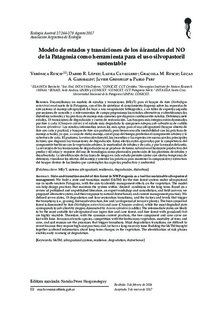| dc.description.abstract | Desarrollamos un modelo de estados y transiciones (MEyT) para el bosque de ñire (Nothofagus
antarctica) en el norte de la Patagonia, con el fin de sintetizar el conocimiento disperso sobre las repuestas de este sistema al manejo silvopastoril. En base a una recopilación bibliográfica, a un taller de expertos seguido por sesiones de consulta y a relevamientos de campo propusimos los estados alternativos e identificamos los disturbios naturales y las prácticas de manejo más comunes que disparan cambios entre estados. Definimos siete estados, 13 transiciones de degradación y cuatro de restauración. Los bosques más íntegros están dominados por ñire y caña (Chusquea culeou) y el estado más degradado lo componen estepas sub-arbustivas de cadillo (Acaena splendens). Los estados intermedios serían los más aptos para el uso silvopastoril (bosque abierto de ñire con caña y pastizal, y bosque de ñire con pastizal), pero tienen una alta inestabilidad con las prácticas de manejo actuales, ya que, a causa de dicho manejo, con el paso del tiempo perderían el componente arbóreo y la
cobertura de caña. El pastoreo, la extracción forestal, los incendios y las especies invasoras son los principales factores que disparan las transiciones de degradación. Estos efectos están agravados por la competencia del componente herbáceo con la vegetación arbórea, la mortandad de árboles y de caña, y por la erosión del suelo.
La reversión de las transiciones de degradación no se produce de forma natural en el horizonte productivo del predio (~40 años) y requiere del uso de tecnologías como plantación, protección de los plantines de árboles y desarbustado. La identificación de las fases de riesgo en cada estado permite contar con alertas tempranas de deterioro, visualizar los efectos del manejo y orientar las prácticas para mantener la composición y estructura del bosque dentro de los límites que contemplan los aspectos productivo y ambiental.
State-and-transition model of ñire forest in NW Patagonia as a tool for sustainable silvopastoral
management. We built a state-and-transition model (S&TM) for the ñire forest system under silvopastoral
use in north-western Patagonia, with the aim to identify management effects on the vegetation. The model
can help design practices that maintain the system within ‘desired’ conditions in the long term. Based on a
review of published and unpublished literature, an expert workshop and consultation, and field surveys we
proposed alternative states and their response to natural disturbances and current management practices. We defined seven states, 13 degradation and four restoration transitions, and the factors and levels that trigger the transitions (i.e., grazing, firewood extraction, fire and/or dispersal of invasive plants). The best-conserved forest is dominated by ñire (Nothofagus antarctica) and cane (Chusquea couleou), while the most degraded state corresponds to sub-shrubby steppes dominated by Acaena splendens (cadillo). The intermediate states are likely to be the most suitable for silvopastoral use (open ñire and cane forest, and ñire forest with grassland) but are highly unstable. Therefore, with the common current practices, the tree component and cane cover are lost with time. Invasion of exotic species, competition with the herbaceous vegetation, mortality of trees and cane, and soil erosion are the processes that trigger transitions. Most degradation transitions are difficult to revert because they require high-cost practices and/or have a long recovery time. Building the S&TM brought together scattered information about long-term changes in the vegetation. The identification of risk phases
enables early warning of degradation. | nb_NO |
